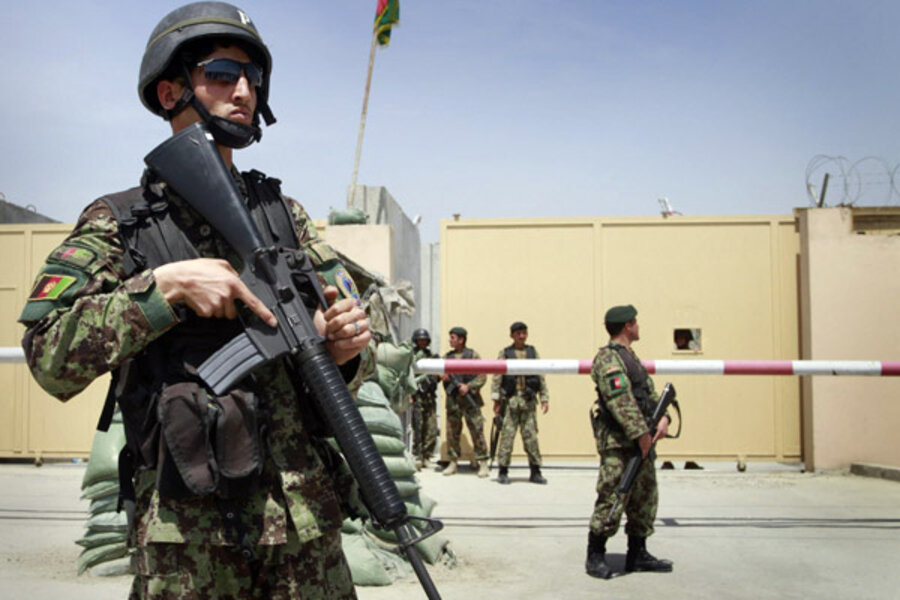US report on Afghan rampage raises questions about NATO’s exit
Loading...
| Washington
A new Air Force report on the murder of eight US troops by an Afghan officer last April paints a disturbing picture of their last moments. During the chaos that ensued, some people jumped out of windows and dived for corners to avoid the AK-47-wielding gunman, who was roaming freely in a highly secure facility.
As US troops ramp up their training of Afghan national security forces – the key to America’s exit strategy in the war – the Air Force investigation has prompted some policy changes. These include stepped-up security measures and more weapons training so that airmen will be able to more quickly “neutralize” a hostile shooter.
But the report also raises some questions about the stalled progress of training to date, as well as the effectiveness of earlier steps taken by NATO trainers, meant to combat corruption within the Afghan Air Force. Some interviewed for the investigation said they feared the new measures would anger Afghans who would lose a lucrative, if illicit, source of income that came from Air Force flights.
The report has sparked charges, too, that NATO officials are now withholding information on the number of allied troops killed by Afghan soldiers and police.
Ultimately, the investigation concluded that the rampage, which began on the morning of April 27, was the act of a lone shooter, Col. Ahmed Gul, rather than a Taliban conspiracy.
But a number of those interviewed for the investigation testified that Gul had become increasingly religious after the Taliban came to power in Afghanistan. Relatives told investigators that Gul lived in Pakistan for a year and a half, beginning in 2006, because “foreigners had invaded his country.” He returned to Afghanistan, according to those interviewed in the Air Force report, because he “wanted to kill Americans.”
Gul would often criticize the religious laxity of his colleagues, warned a colonel with whom he had served at the Afghan Air Force Military Academy. The colonel, whose name was redacted in the report, told investigators that in the prior 10 months he had noticed “drastic changes” in Gul’s way of life. Specifically, Gul had become more religious, with Islamic views that “were boiling over and extreme,” the colonel said.
Gul was also attending a mosque led by a mullah who was “extremely anti-American and pro-Pakistan,” the colonel added. He said he had phoned the Afghan Air Force’s internal affairs office “on multiple occasions, informing them that [Gul] was mentally and financially unstable.”
Though it was not customary for an Afghan Air Force officer to receive a pistol immediately upon taking a new post, according to the colonel, Gul received one within four months of his arrival. In his job, he was prone to bouts of anger “if things were not going his way.” He was also “irresponsible” and frequently late.
For these reasons, the colonel told investigators that he suspected Gul had “ ‘top cover’ from a higher-ranking officer in the [Afghan] MOD [Ministry of Defense].”
The investigation also uncovers a common source of concern among the allies they interviewed – namely, that Afghan Air Force officials make money on the side by using Air Force planes for deliveries and transportation for cronies. But they feared that efforts to tamp down these practices would be met with resentment among Afghan counterparts.
There was some discussion, too, that Gul was in a financially precarious state. At the time of the shooting, he had sold his house to pay off debts and was living in his car.
Gul shot himself in the chest after killing eight US troops and one US contractor, many of whom he shot in the back of the head at point-blank range.
The propensity of other Afghan officers to do similar harm to US troops has been an ongoing source of concern for NATO forces in Afghanistan. According to data compiled by USA Today, more than 50 troops have been killed and an equal number wounded by Afghan security forces since 2005. In 2011, Afghan troops killed at least 13 NATO troops.
But these figures may be increasingly hard to come by. On the heels of the Air Force investigation came charges from USA Today that NATO forces are no longer releasing specific data about troops killed by Afghan soldiers and police.
An International Security Assistance Force spokesman, US Navy Lt. Cmdr. Brian Badura, tells the Monitor that perhaps reporters could get such information in the past, but current policy is not to “aggregate” data.
“We don’t have the capacity to track over time, nor the personnel resources to run a data bank,” Badura said in an e-mail.





